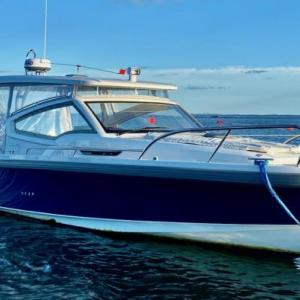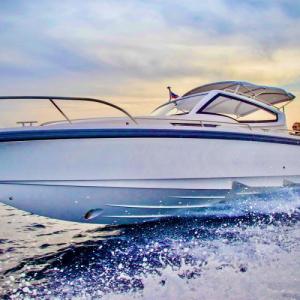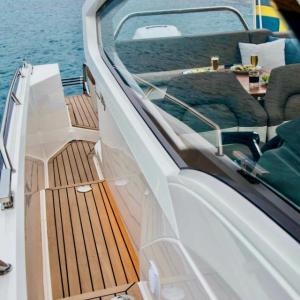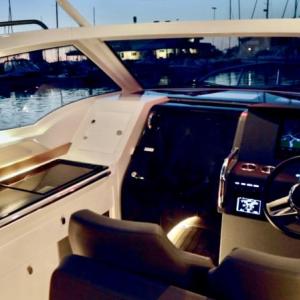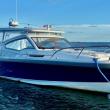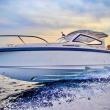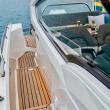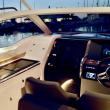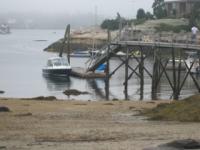The Sea-Going Volvo: Nimbus W9
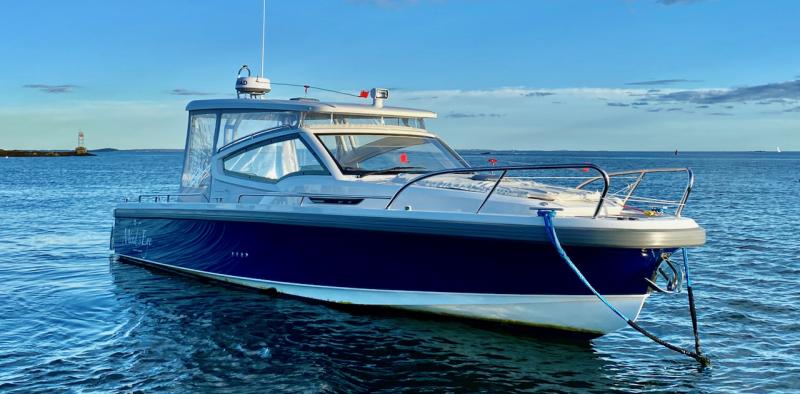 A well-equipped Nimbus W9 buttoned up against the Maine weather with full side curtains and an electrically powered sunroof. The mooring bridle takes advantage of both cleats on the bow. The electric anchor windlass can be operated with a remote control from anywhere on the boat; the remote also can run the bow thruster. The touches of orange are wind vanes on accessory whirligigs meant to deter gulls and cormorants.
A well-equipped Nimbus W9 buttoned up against the Maine weather with full side curtains and an electrically powered sunroof. The mooring bridle takes advantage of both cleats on the bow. The electric anchor windlass can be operated with a remote control from anywhere on the boat; the remote also can run the bow thruster. The touches of orange are wind vanes on accessory whirligigs meant to deter gulls and cormorants. 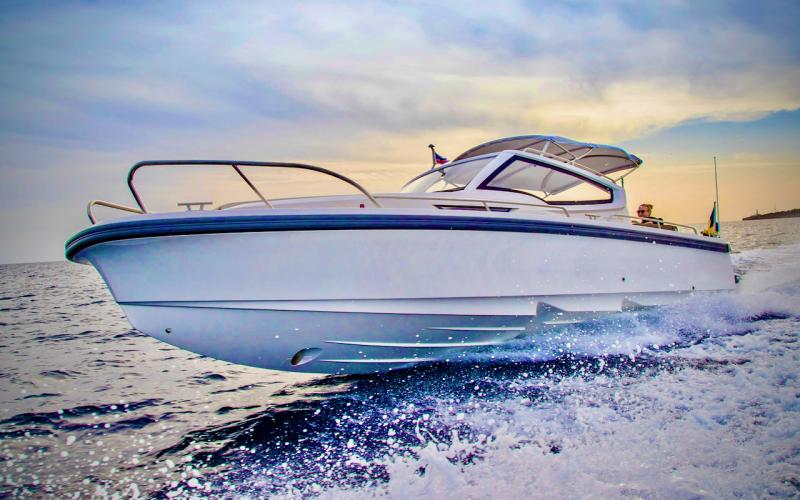 The two steps of the WTC boats’ “air-lubricated” underbody show clearly here. The ride is unusually comfortable and dry, and visibility over the bow is excellent even when the boat is transitioning to plane. The smooth forefoot lets the boat run up onto a sandy beach for a picnic, which is much more practicable in the Baltic Sea, with its 12-inch tides, than it is in Maine, where the tidal range may be 12 feet.
The two steps of the WTC boats’ “air-lubricated” underbody show clearly here. The ride is unusually comfortable and dry, and visibility over the bow is excellent even when the boat is transitioning to plane. The smooth forefoot lets the boat run up onto a sandy beach for a picnic, which is much more practicable in the Baltic Sea, with its 12-inch tides, than it is in Maine, where the tidal range may be 12 feet. 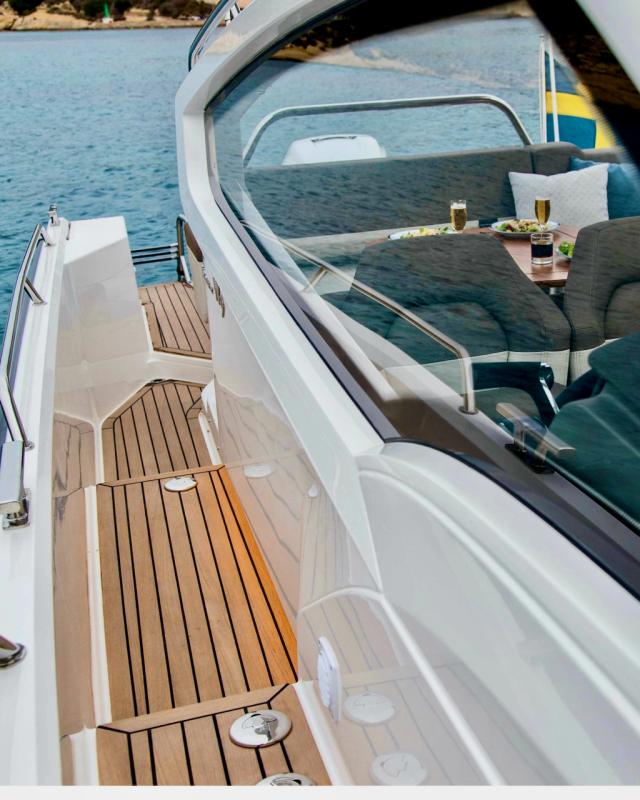 Another unusual feature of the WTC line is what Nimbus calls the Sidewalk: The cabin sits slightly left of the boat’s centerline, which provides extra space to walk forward on the starboard side without reducing the width of the cabin. If there’s a downside, it’s that the boat is meant to be docked only on that side; there’s no easy access to the port rail.
Another unusual feature of the WTC line is what Nimbus calls the Sidewalk: The cabin sits slightly left of the boat’s centerline, which provides extra space to walk forward on the starboard side without reducing the width of the cabin. If there’s a downside, it’s that the boat is meant to be docked only on that side; there’s no easy access to the port rail.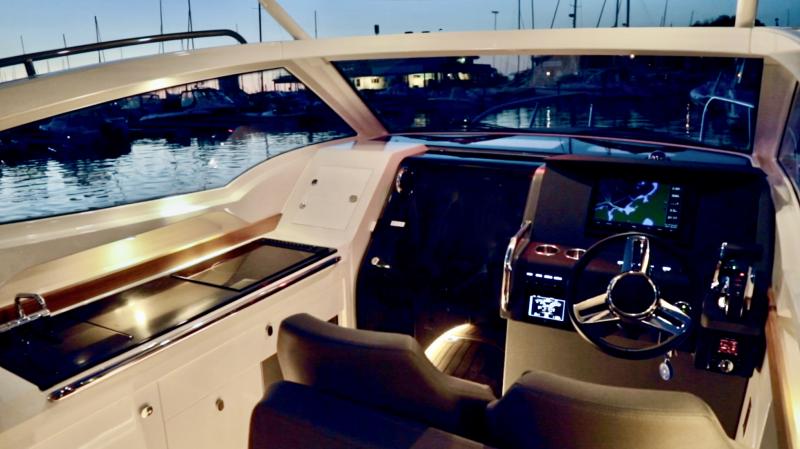 The helm station with its adjustable bucket seats. One large or two smaller computer screens are available, which show course and depth, boat speed, engine RPM, fuel consumption, trim and much, much more. In low visibility, a radar overlay on the chartplotter provides security, backed up by a VHF radio with AIS, Automatic Identification System. The galley, with its refrigerator, propane stove and shelves stocked with Nimbus dishes and flatware, is on the left. The sliding door leads to a comfortable V-berth cabin with storage space, ventilation, heat, lighting, sound and a full enclosed head (no shower).
The helm station with its adjustable bucket seats. One large or two smaller computer screens are available, which show course and depth, boat speed, engine RPM, fuel consumption, trim and much, much more. In low visibility, a radar overlay on the chartplotter provides security, backed up by a VHF radio with AIS, Automatic Identification System. The galley, with its refrigerator, propane stove and shelves stocked with Nimbus dishes and flatware, is on the left. The sliding door leads to a comfortable V-berth cabin with storage space, ventilation, heat, lighting, sound and a full enclosed head (no shower).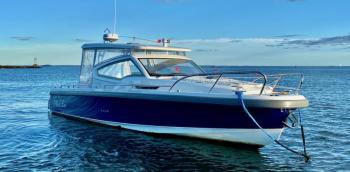 A well-equipped Nimbus W9 buttoned up against the Maine weather with full side curtains and an electrically powered sunroof. The mooring bridle takes advantage of both cleats on the bow. The electric anchor windlass can be operated with a remote control from anywhere on the boat; the remote also can run the bow thruster. The touches of orange are wind vanes on accessory whirligigs meant to deter gulls and cormorants.
A well-equipped Nimbus W9 buttoned up against the Maine weather with full side curtains and an electrically powered sunroof. The mooring bridle takes advantage of both cleats on the bow. The electric anchor windlass can be operated with a remote control from anywhere on the boat; the remote also can run the bow thruster. The touches of orange are wind vanes on accessory whirligigs meant to deter gulls and cormorants. 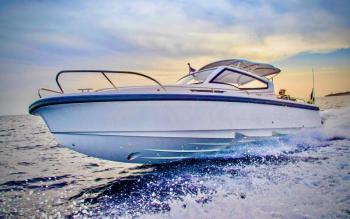 The two steps of the WTC boats’ “air-lubricated” underbody show clearly here. The ride is unusually comfortable and dry, and visibility over the bow is excellent even when the boat is transitioning to plane. The smooth forefoot lets the boat run up onto a sandy beach for a picnic, which is much more practicable in the Baltic Sea, with its 12-inch tides, than it is in Maine, where the tidal range may be 12 feet.
The two steps of the WTC boats’ “air-lubricated” underbody show clearly here. The ride is unusually comfortable and dry, and visibility over the bow is excellent even when the boat is transitioning to plane. The smooth forefoot lets the boat run up onto a sandy beach for a picnic, which is much more practicable in the Baltic Sea, with its 12-inch tides, than it is in Maine, where the tidal range may be 12 feet. 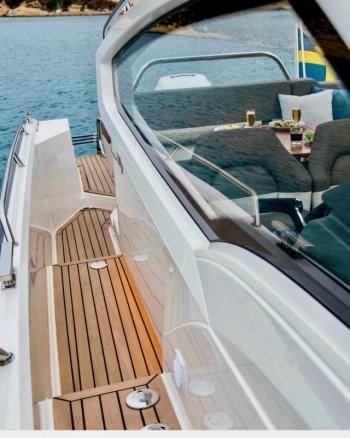 Another unusual feature of the WTC line is what Nimbus calls the Sidewalk: The cabin sits slightly left of the boat’s centerline, which provides extra space to walk forward on the starboard side without reducing the width of the cabin. If there’s a downside, it’s that the boat is meant to be docked only on that side; there’s no easy access to the port rail.
Another unusual feature of the WTC line is what Nimbus calls the Sidewalk: The cabin sits slightly left of the boat’s centerline, which provides extra space to walk forward on the starboard side without reducing the width of the cabin. If there’s a downside, it’s that the boat is meant to be docked only on that side; there’s no easy access to the port rail.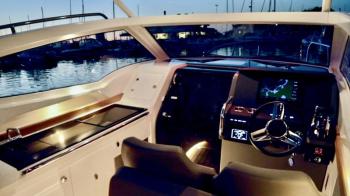 The helm station with its adjustable bucket seats. One large or two smaller computer screens are available, which show course and depth, boat speed, engine RPM, fuel consumption, trim and much, much more. In low visibility, a radar overlay on the chartplotter provides security, backed up by a VHF radio with AIS, Automatic Identification System. The galley, with its refrigerator, propane stove and shelves stocked with Nimbus dishes and flatware, is on the left. The sliding door leads to a comfortable V-berth cabin with storage space, ventilation, heat, lighting, sound and a full enclosed head (no shower).
The helm station with its adjustable bucket seats. One large or two smaller computer screens are available, which show course and depth, boat speed, engine RPM, fuel consumption, trim and much, much more. In low visibility, a radar overlay on the chartplotter provides security, backed up by a VHF radio with AIS, Automatic Identification System. The galley, with its refrigerator, propane stove and shelves stocked with Nimbus dishes and flatware, is on the left. The sliding door leads to a comfortable V-berth cabin with storage space, ventilation, heat, lighting, sound and a full enclosed head (no shower).For the first time in 30-some years, upon my return from Alaska there was no press vehicle waiting for me at the airport to drive home. The NEMPA—New England Motor Press Association—fleet is as dry as the lakes, streams and wells across New England, but this is due to the man-made threat of tariffs and other financial uncertainties rather than natural drought.
However, the brass here at the Pilot once said they’d take reviews of boats as well as land-based motor vehicles, so let me introduce the Nimbus W9, a sophisticated yet value-priced import from Sweden. Think of it as a sea-going Volvo XC60; the level of fit & finish is that good. The performance, relatively speaking, is even better.
W9 stands for 9-metre Weekender. Nine metres is 29’-6” and the boat actually tapes out at 31 feet, but why quibble? (A meter, btw, is an instrument, hence metre for length.) Nimbus has been building boats since 1968, but the first one of this type I ever encountered was in Norway a few years ago, and its rakish look caught my eye. It occurred to me then that, since the rocky, island-rich Scandinavian coast resembles offshore Maine, what works there should work here, too—just like Volvos, which also are at home in Maine. It makes sense to buy boats, or cars, that are designed and built in the sort of climate and conditions where they’ll be used.
The W9 is part of the Nimbus WTC series, for Weekender, Tender and Commuter—different cabin configurations on an “air-lubricated” hull that provides seaworthiness, stability and great visibility. The sharp bow flattens out to two steps underneath for a minimal planing threshold, while a low center of gravity and a beneficial length-to-width ratio lets the boat cover water safely, quickly and in unusual comfort. Although they don’t sit high off the sea, Nimbus WTCs are also notably dry, which increases the sense of security.
Their performance, especially for enclosed 30-foot family boats, is astonishing. In calm conditions, with a single 300-horsepower Mercury Verado V-8, the W9 tops out near 50 miles per hour. At that speed in Maine waters, lobster-pot buoys and lines come up very quickly; the helmsperson has to pay constant, close attention. It’s often less stressful to throttle back to 35 MPH, at about 4900 engine RPM. The WTC hull tracks well in a straight line, but it can change direction quickly and predictably, with no slip.
Overall fuel efficiency averages right around 2 MPG, which is outstanding for a boat of this size and capability. But imagine a Volvo that needed a gallon of gas to cover two miles of road? Prices too are vastly different between automobiles and powerboats. Depending on options, a W9 can top $320,000—before the 15% Trump Tariff—and yet this is much less than some other comparable boats. Still, a Volvo that costs one-third as much is more complex than even such a refined boat as a Nimbus. Enormous economies of scale are at work here; if as many boats were sold worldwide as cars, their prices would even out.
On the other hand, boats generally do not evolve as quickly as cars—the competition for sales, and the need to be always bigger, newer, flashier, isn’t as cutthroat. A well-kept five-year-old W9 is virtually no different from a new one, but can be bought for much less.
Like cars and pickup trucks, powerboats are designed to meet certain needs and uses. The W9 could have been created with Penobscot Bay in mind. Leave after work on a Friday in July and it’s possible to be anywhere in the bay before dark. Pick up a mooring—you called ahead to reserve space—or put down the anchor, radio the nearby yacht club or marina to be picked up, and go ashore for dinner in Castine or Bucks Harbor or Stonington. Or cook on board in the galley. Spend the night in the comfortable forward cabin with en suite bathroom. Do it all over again the next day in a different picturesque village, and easily be home Sunday afternoon in time for cocktails at the mooring. That’s why the Swedes call it a Weekender.

